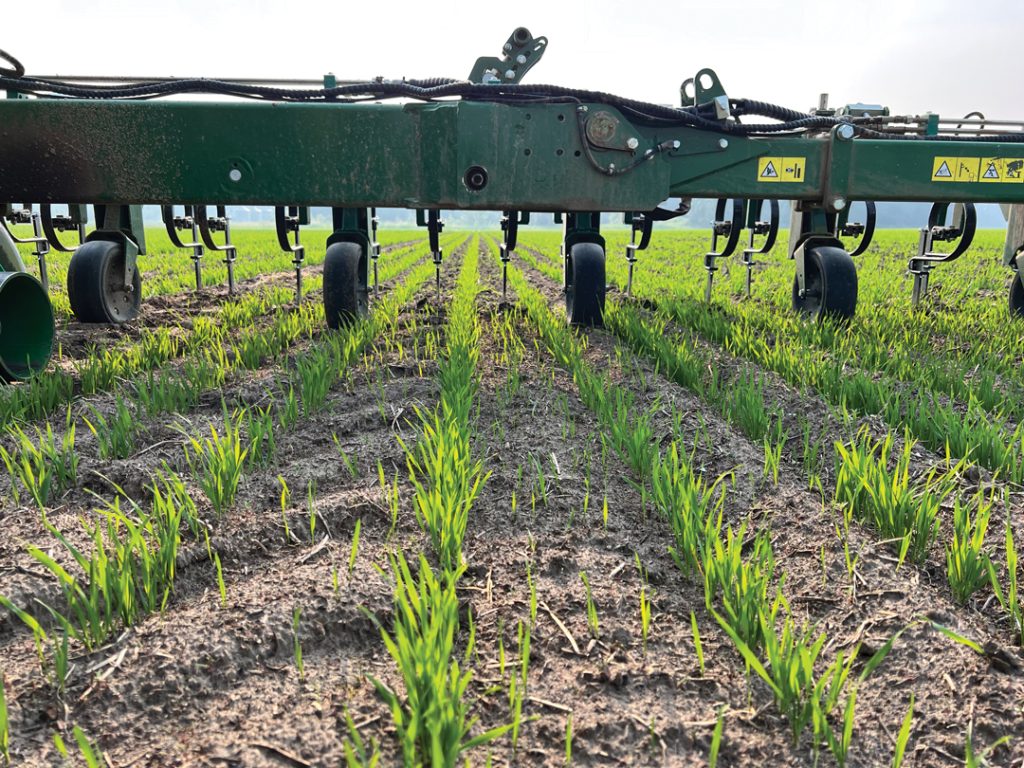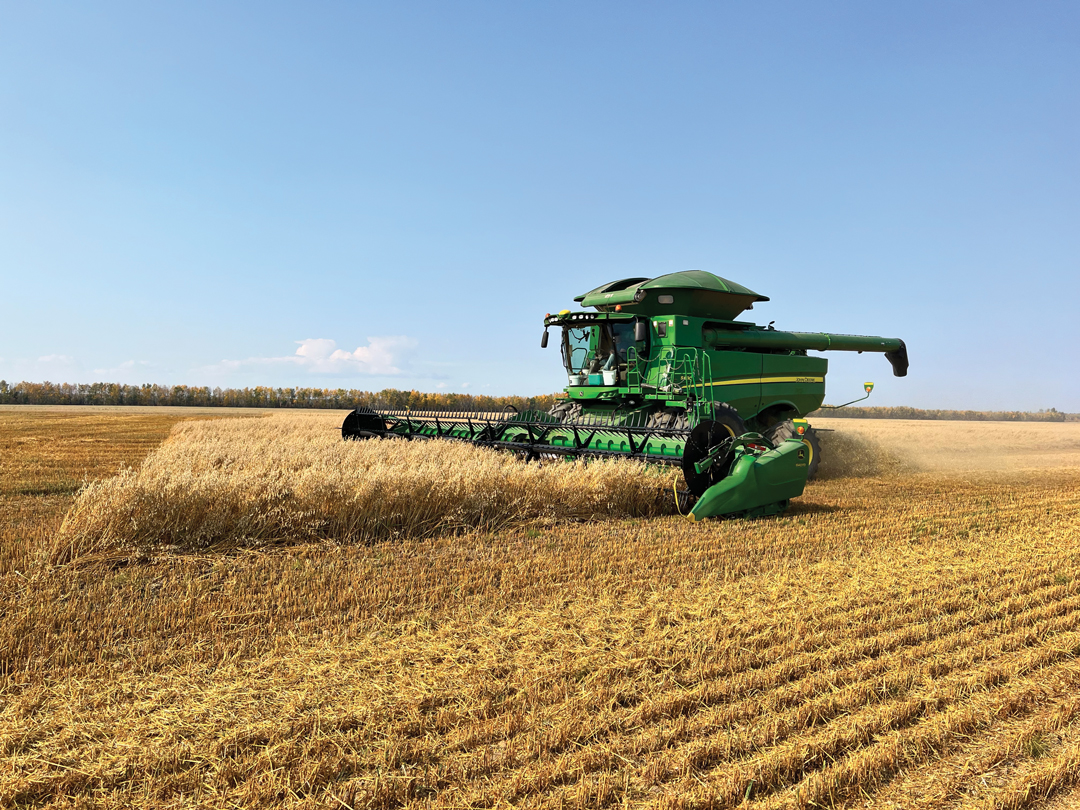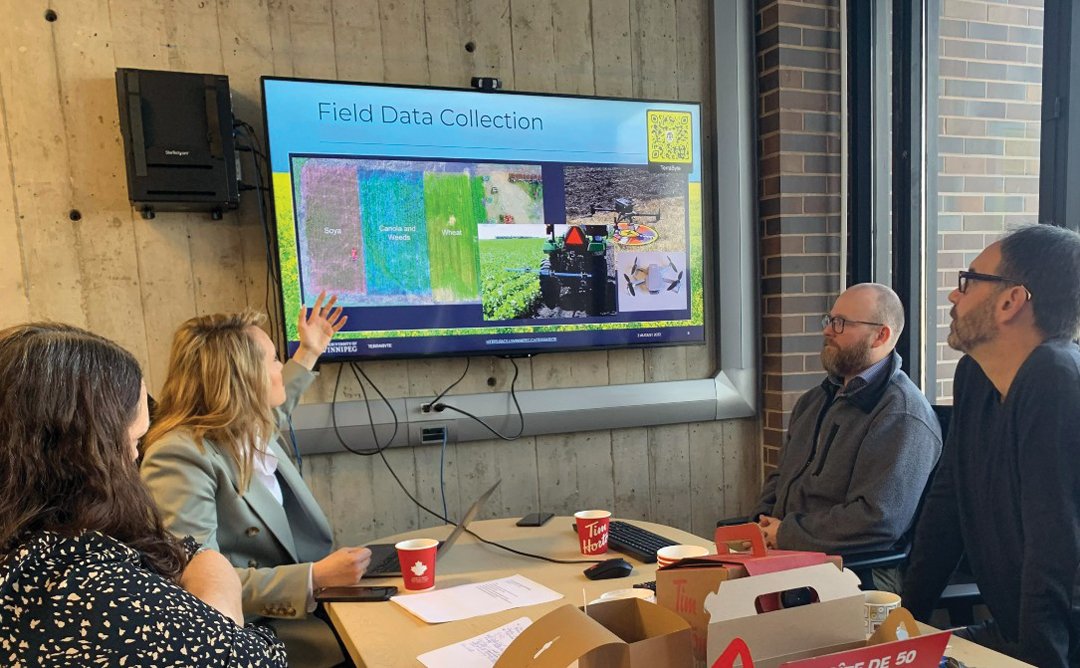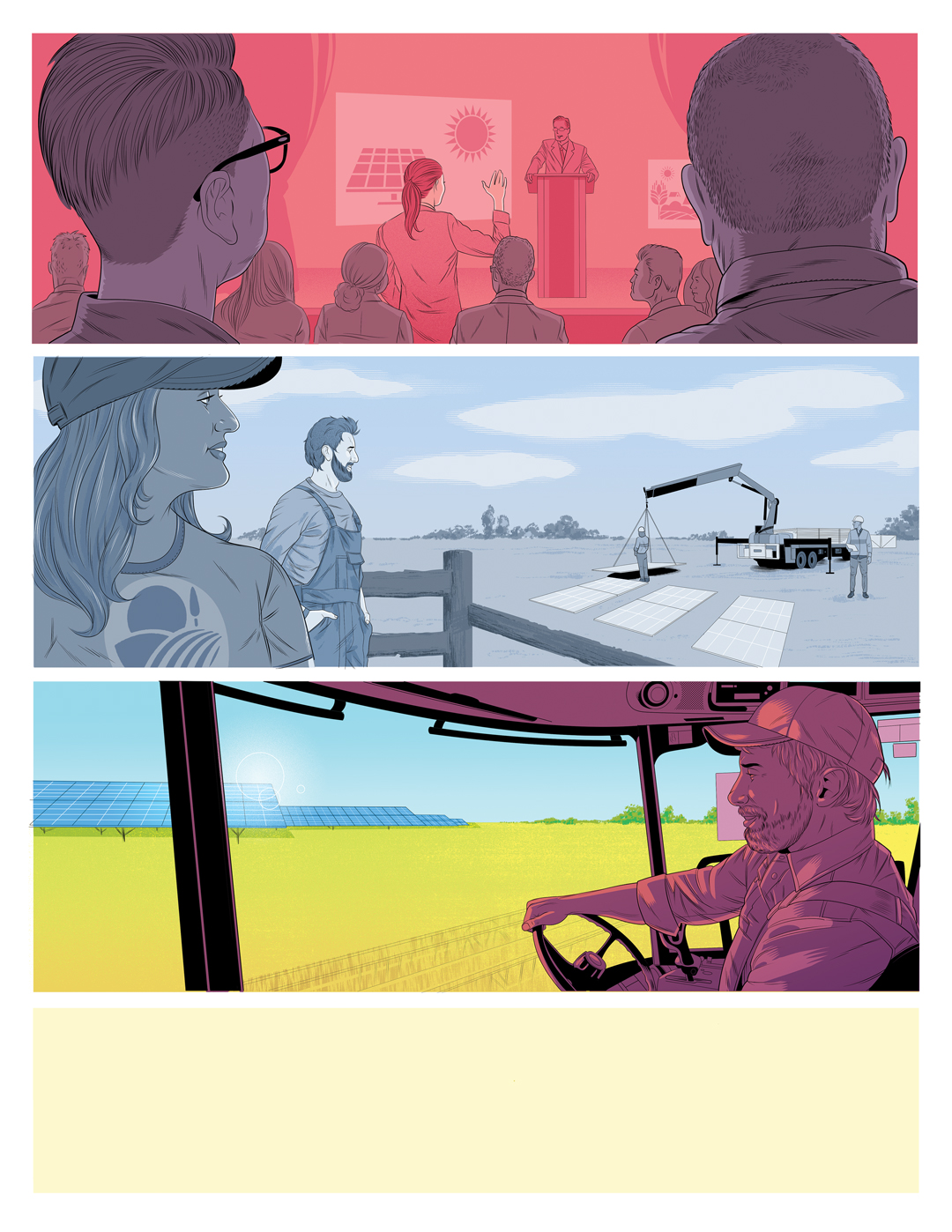ORGANIC GROWTH
BY KAITLIN PACKER BERGER • PHOTOS COURTESY OF JOASH SIEMENS
As consumer demand for organic cereals grows, so does the draw for farmers to serve this specialized market with its premium prices. GrainsWest spoke with organic farmers who said this premium is typically 1.5 to two times greater than conventional pricing. The rising cost of conventional inputs and farmland make it an attractive option for those who want to grow a highly profitable crop while they carry less overhead. But it’s not a one-size-fits-all approach. This non-conventional sector requires strategic farm management on an individual level and, more broadly, the support of continued research and innovation to drive it forward.
The number of farms entering the organic industry is on the rise. “Three per cent of all farms in Canada are certified organic now,” said Tia Loftsgard, executive director of the Canadian Organic Trade Association (COTA). She recalled that about a decade ago, approximately just 800 certified organic farms existed across Canada. The total is now 6,069 with 571 of these in Alberta. The country’s 3.8 million acres of organic production include 1.14 million acres of field crops. “Do I think it will continue expanding? Yes, definitely,” said Loftsgard.
A challenge to the growth of organic production, particularly for conventional farmers who wish to take it up, is its three-year transition period during which no pesticides or synthetic fertilizers can be applied to the field. “When you start your organic journey, you’re committing to these new production practices,” said Loftsgard.
Because certified organic farmers are audited on a yearly basis for their adherence to Canadian Organic Regime (COR) standards, the paperwork is no picnic either. Everything you put in your soil must be documented. This is necessary to verify organic practices are adhered to but may also assist a farmer in fine-tuning their practices. “You need to be able to prove it to a certifier, and it makes you really pay attention to the practices you’re adopting,” said Loftsgard.
The reduced cost of chemical inputs is a key upside, but organic operations also typically require more labour than conventional farms. “It’s more of a technique where you need to be paying attention and you can’t just do everything monocropping like you could do in conventional and just spray it all to keep the weeds down,” she said.
Strategies such as the Organic Action Plan, now being developed by COTA, the Canadian Organic Growers and the Organic Federation of Canada, can address the challenges organic farmers face and propel the industry to further growth. “Every great agricultural nation has an organic policy framework and an organic action plan,” said Loftsgard. “Canada is the only one that does not.” The purpose of the plan is to develop a framework for the industry’s production and market needs and the research required to further its success, all in conjunction with governmental policy demands.
These demands include the federal goal to reduce greenhouse gas emissions from fertilizer by 30 per cent below 2020 levels by 2030 and the COP15 biodiversity strategy, which requires countries around the globe to reduce environmental risks posed by pesticides, though not necessarily the amount, by 50 per cent by 2030. “The time is now, because the government has made these commitments and they need a concrete strategy on how to get there,” said Loftsgard. She noted Canada has the fifth-largest organic market in the world, and the right strategy could bump it higher.

A STRONG MARKETPLACE
Traceability is a characteristic that sets Canada apart on the global food market. “If you want to buy a bag of organic oatmeal in Canada, you could trace back to a set number of farms that product came from,” said Michael Strebchuk, president of the Alberta Organic Producers Association (AOPA) and a third-generation farmer in the High Prairie area. In addition to a custom cattle-feeding operation, he grows cereals and forages on approximately 1,200 certified organic acres. “That traceability does not exist in some of the other countries around the world that are certified organic.”
This is largely due to the certification process required of Canadian organic farmers through the COR. “We have to meet those standards, but how we get there [varies],” said Strebchuk. Farmers may choose to certify through associations such as AOPA or the TransCanada Organic Certification Services, a not-for-profit group operated by its farmer members.
Until 2009, Canadian organic farmers were certified under the American standard. Now that farmers can receive Canadian certification, export opportunities have increased. “In the past, if I wanted to sell to the EU, I would have to be inspected and certified by a body in the EU,” said Strebchuk. While most organic cereal production is still exported to the U.S., he believes trade opportunities with the EU and Japan are on the rise.
There is demand for all types of organic cereal crops, but wheat and oats top the list. Food-grade cereal grains such as milling wheat have the biggest market, whereas there is less interest in feed grains. “There seems to be a greater demand for oats, and I think that’s mostly because of your granola bars, your cereals, things like that,” said Strebchuk.
Gordon Wood is an AOPA director who farms south of Red Deer. “Right now, we’re selling organic wheat to a flour mill in Calgary, and then we’re growing organic wheat for people to grind for themselves.” He said the demand is great enough he will need to expand his 250-acre operation to keep up.
The direct-to-buyer marketing process often used sets the organic industry apart from conventional. “If I want to sell my grain, I’m calling multiple buyers to try and find the best price,” said Strebchuk. There are many individual opportunities to market grain in relatively small quantities. Strebchuk noted this niche includes spelt, Kamut and Red Fife, though he sticks to standard varieties on his farm.
Organic farmers also supply grain to the craft brewing industry. Microbreweries are invested in the creation of products that are uniquely tasty and tell a compelling story. To this end, they may use locally grown organic malting barley. “They can put the face of the farmer that they bought the grain from on their label and say this is locally grown,” said Strebchuk. “That fits hand in hand on the organic side of things, because we’ve been [telling individual farm stories] for years.”
Consumer commitment to the purchase of organic products ultimately creates market opportunities. “The general population sees an advantage to growing organic and eating organic, and that’s exciting to see,” said Strebchuk. The rising cost of food hasn’t seemed to impact demand like it did when the American economy tanked in 2008 and 2009. “It bodes well for our industry that people have bought into it and are now faithful to it,” he added.

IN THE FIELD
Strebchuk also believes the number of people in the agriculture industry who perceive an advantage in organic production has dramatically increased from when organic farming really started to develop in the 1970s. “You were either a hippy or you were this filthy farmer who was just too lazy to actually farm properly,” said Strebchuk. “That mentality is shifting.”
Because he grows an organic product, Strebchuk pays significant attention to soil health. “I want to pass to the next generation, to my children, a healthier farm than what I inherited from my dad,” he said. He has developed a rotational system in which his cattle graze cover crops during late summer or fall in fallow years and spread manure on fields that will be put into production the next season.
Weeds are one of the biggest challenges for Strebchuk and Wood, and both rely on integrated management practices to enrich the soil. Wood uses a higher seeding rate to minimize weeds and plants crops such as green clover that he plows down prior to manure application. He also has good results with companion crops such as wheat with barley or barley with oats. “We’re trying two or three different crops that are easy to clean out of each other,” he said.
Strebchuk employs cover crops to ensure live plants remain on the land throughout the season. “If I’m doing a fallow year, what I will do is plant a multi-species cocktail mix in the spring and it will grow all season, die off and be put back into the [soil] for the following year,” he said.
According to Strebchuk, this is a significant improvement to traditional summerfallow practice where farmers would leave the soil black and till any weeds that arose. “Every time you drop a piece of equipment into the soil, you’re cutting up the fungi. In essence, you’re killing the biology that’s in the soil. If you can till it in the spring and then seed it and leave it all summer to be fed [by biological activity], you have something to work with the following spring.”
The price one pays to purchase land determines the profit it must generate annually. “Much of that land in that higher dollar-value belt has to grow a crop every single year,” said Strebchuk. To go organic and plant cover crops during fallow years is more practical in a region with lower land value. Strebchuk pointed out a lot of organic farmers, himself included, farm marginal land, graze cattle and do not necessarily grow a crop in every field each year.
Joash Siemens saw the opportunity to profit on marginal land by transitioning from conventional to organic. He owns 58th Parallel Organics, a farm near La Crete. When the government sold bushland in his region of the Peace Country more than a decade ago, he joined the throng of farmers who purchased it for organic production to fetch premium prices. “You’ve got to transition the land, but for this land that was coming out of bush, it was instantly organic,” he said. His purchase included 320 acres of bush.
He guesses more than half of these farmers have gone back to conventional farming due to weed problems or the hassle of organic paperwork. He decided to transition the balance of his approximately 3,100 organic acres of owned and rented land to produce organic oats, peas and wheat. “We felt like we were making more money on our organic land than double the acres on conventional, but then it came with a lot of other benefits such as not having to have the chemical around in the yard, and it seems like we have better soil health,” he said.
Becoming an organic farmer was a risk management strategy, he added. When he was a conventional farmer, the high overhead for fertilizer and chemical inputs meant greater loss in a drought year, one that had to be recouped the following season. As a young farmer with a growing business, he decided he doesn’t want to have money-losing years. “I might have years when I make a lot less, but you’re always kind of working ahead,” he said. This type of financial progress appeals to him.
While farming the northerly reaches of the Peace has its challenges, the region’s long growing season is a huge upside. “We get sunlight 20 hours a day, so we grow really, really good oats up here,” said Siemens. “I’ve had different oat buyers say we grow the best oats in North America.”
Siemens uses zero chemical inputs but finds he is well positioned to battle bug pressure. “When we were conventional, we’d always be spraying for bugs,” he said. Grasshoppers and worms used to be a major challenge in the farm’s canola, but the problem has faded. “There’s a healthy balance in it. You have your beneficials, along with your predators.”
Similarly to Strebchuk and Wood, weeds are his biggest challenge. He said he couldn’t manage them without his European Garford in-row cultivator. Its camera-guided shovels till the 10-inch space between rows. He pairs this tool with a strategic four-year rotation of oats, peas and a year of cover crops. He fallows 25 per cent of his land each year.
Though organic crops are grown quite successfully in northern Alberta, trucking costs are a massive challenge for smaller organic farmers where there’s no local buyer. Siemens solved this problem with the creation of his own grain trading business, Simply Grain. “I can collect everything together, figure out the quality, clean it if I need to and then sell it further,” he said. The symbiotic relationship benefits farmers who prefer not to handle their own grain marketing or don’t want to truck half-loads of grain south.

RESEARCH AND DATA NEEDED
Increasing land competition in their area near Alix prompted Chris and Leah Simeniuk to go organic on their 1,400-acre farm in 2015. They saw an opportunity to produce more revenue per acre by fully transitioning from conventional. Each year, they sow half their acres to cash crops that include wheat, barley, rye and mustard, and the balance is sown to cover crops.
Logistics are a challenge. “Everything is a longer plan,” said Chris. “You can’t go out and spray your problem away.” As the couple developed their organic operation, they saw further opportunity to boost their bottom line through positive agronomic practices. “Our agronomy bill is significantly more now than when we were conventional,” said Chris. This is largely due to the effort they put into cover crops, tissue tests, soil tests and variety studies.
For both organic and conventional farming, Chris believes cover crops are an underutilized tool. “Even if we quit organic and went back conventional, the cover crops and underseeding clovers is something I would keep in my toolbox.” Part of their cover crop management strategy includes the reduction of tillage to a four-week period every 24 months. “We aim for living roots, living crop on our lands, 23 out of every 24 months.”
Being in a niche market, it has been difficult for the Simeniuks to find organic cropping data and research relevant to their region of Alberta. To compensate, they plan to conduct their own on-farm trials this summer. “The biggest learning curve is trying to dial in these cover crops for our area as far as nutrient replacement, weed management and to get the best benefits out of them,” said Chris. Working with their agronomist and research groups, their goal is to measure the amount of biomass the clovers produce and evaluate termination methods such as tillage and grazing.
As the number of organic farms across Alberta grows, more such regional research will inevitably be generated. Nonetheless, organic operations tend to be unique, which forces a certain amount of self-generated knowledge gathering. Each farmer must find their own solutions to the challenges of organic production in their region. “On the organic side, everybody does a different thing,” said Chris. “Each person is a story unto their own.”







Comments